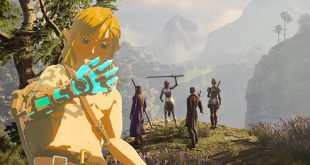Here Develop shines a spotlight on all the key new features and enhancements to Autodesk’s 2012 software suite, confirmed today and on sale this April.
3ds Max 2012
The newest version of Autodesk’s widely used modelling, animation, rendering and compositing application has been restructured with an emphasis on improved in workflow, user interface and performance.
It’s also bolstered by Nitrous – a rewritten multi-threaded accelerated graphics core that promises to improve overall productivity. And, like all the 2012 tool updates from Autodesk, 3ds Max 2012 features single-step interoperability with the company’s other products to smooth workflow for artists.
Delving deeper into 3ds Max 2012, a new library of 80 Substance smart textures and filters – tiny, multi-output, customisable and resolution-independent – have been added, as has a new feature is mRigids Rigid-Body Dynamics; the first module released in the new MassFX unified system of simulation solvers. It lets artists use the multithreaded Nvidia PhysX engine to create dynamic rigid-body simulations directly in the 3ds Max viewport.
Meanwhile the newly integrated, Nvidia GPU accelerated iray rendering technology enables users to achieve more predictable, photorealistic results without having to concern themselves with rendering settings; something Autodesk is comparing to the simplicity of point and click cameras in contrast to the complexity SLRs.
Also new to 3ds Max 2012 is the enhanced UVW unwrapping, which lets artists create better UVW maps with less investment of man hours, thanks to the Least Squares Conformal Mapping (LSCM) method, which preserves local angles of mesh faces in order to help minimise texture distortion.
Sculpting and painting enhancements have also been implemented, letting 3ds Max customers enjoy greater control over brushstrokes and their effects on geometry. Particularly interesting is a new conform brush, which has been conceived to be useful in topology reduction workflows. It guides geometry towards another surface, with the degree of the conforming effect varying from softly approaching to shrink-wrapping.
Other enhancements to FBX file link, ProOptimizer, UI and several other elements make 3ds Max’s 2012 update one that should prove remarkably popular with its users.
Maya 2012
The enhancements to Maya 2012 are no less substantial than those to 3ds Max. The rendering and compositing software introduces a number of toolsets for previsualisation and prototyping, as well as extended simulation capabilities and better pipeline integration.
Foremost of the upgrades are the improvements to Viewpoint 2.0, which now provides users with motion blur, depth-of-field, and ambient occlusion full-screen effects, meaning artists can evaluate their creations in a high fidelity environment without having to render or export to game engine.
The ability to create and edit node-based representations of render passes and render the composited output directly using the mental ray renderer has also been introduced. This provides a tool for verifying and refining render passes prior to handing them to the compositor. The node-based render passes also allow artists to perform some simple compositing tasks without the need to leave Maya.
Maya 2012 also now supports the editing of animation directly in the viewport, without the need to switch context to the graph editor. The editable motion trails again simplify the workflow and potentially save vast amounts of time, in this case by letting animators intuitively edit the position and timing of keyframes in relation to an animated object, while viewing the path of motion over time in 3D space.
Additionally the Camera Sequencer introduced in Maya 2011 is now extended to offer a Sequencer Playlist; a feature that grants artists the power to manage their sequences through a configurable spreadsheet view that provides the ability to reorder clips, edit In and Out points, and change camera assignments.
A library of 80 textures and filters has also been added, and four new camera rigs from the Craft Director Studio animation tool are added for the creation of believable, complex camera movements that mimic real-world setups.
New simulation options that incorporate the multithreaded Nvidia PhysX engine have also been established to allow for static, dynamic and kinematic rigid-body simulations directly in the Maya viewport.
Softimage 2012
The 2012 update to 3D character animation and visual effects software Softimage includes a large number of upgrades, the most significant of which are the new procedural ICE modelling, integrated Syflex cloth simulation, increased capabilities to support stereoscopic work, and like many of the other Autodesk tools, multiple improvements to the viewport display.
The new procedural ICE modelling enables non-destructive geometry creation, based on rules, conditions and parameters that facilitate topology operation creation, particle meshing, custom primitives and geometry fracturing, all while preserving UV attributes. Meanwhile the Syflex integration enables more flexible node-based workflow of ICE to create and edit highly realistic cloth effects.
An ICE FX Builder module menu toolbar has also been added, which automatically connects compounds and nodes for the simple modification and extension of effects using the standard editing workflow.
Elsewhere the updated Lagoa Multiphysics framework lets artists build realistic simulations of the dynamic behaviour of liquids, cloth, foam, plastic and soft body collisions, as well as incompressible fluids, inelastic, elastic and plastic deformations.
Mudbox 2012
Mudbox’s 2012 version introduces a number of new and enhanced features that are designed to make the process of painting both more efficient and flexible.
Of all the updates, the option of UV-less painting will perhaps save the most hours in a working day, as it grants texture artists the ability to eliminate or reduce the time-consuming endeavour of crafting UVs. The resulting textures can then be exported as Ptex files for an entirely UV-free process, or, for pipelines requiring UVs, baked into UV space.
Mudbox 2012 also features a new texture and tile management system that lets users paint and manage large texture datasets, and includes new paintable layer masks for paint layers that enable artists to selectively reveal or hide portions of layers.
An additional newly introduced ability to deform stencils to align texture data enables the use of available images to rub or project detail onto models to underlying model features.
A wealth of other performance improvements to Mudbox 2012 have been implemented to assist artists looking to paint and sculpt more smoothly at higher resolutions
MotionBuilder 2012
While MotionBuilder is geared most explicitly to film makers wanting to harness its virtual movie-making and performance animation functionality, it remains a popular tool with many game developers.
That considered, many of the 2012 updates will be of particular interest to games studios. Take, for example, the unification with Autodesk’s middleware solution IK, which sees more coherent workflows and improved interoperability between the products, which in turn means MotionBuilder will work more consistently with a given game engine.
Furthermore, new live video-in means reference video from a motion capture session can now be streamed directly into MotionBuilder and recorded simultaneously in parallel with motion capture data on a per-take basis. Previously handled as a separate process, this new feature will let users better visualise the end results, meaning they can troubleshoot errors, reducing the need for later, more disruptive changes.
Motionbuilder has also undergone a UI scheme overhaul, which consumes less screen real estate, and provides greater consistency with other products in the Autodesk suite of tools.
2012 Middleware
As well as picking up Scaleform, Autodesk has also made efforts to improve its existing middleware offering. Global illumination tool Beast, character animation solution HumanIK, and AI software Kynapse have all been updated for their 2012 versions.
Beast’s improved API means games developers can integrate the eRnsT interactive lighting preview tool into custom game level editors, while its new UE3 integration makes it easier for those using Unreal Engine with the popular solution in their projects.
moving on, in keeping with Autodesk’s move on portable devices, inverse kinematics system HumanIK has been optimised for mobile platforms, enabling its users to apply its functionality to their iOS and NGP titles.
Finally, Kynapse has undergone what is probably the most substantial update to any of Autodesk’s middleware. It now uses significantly less memory and provides better performance for those harnessing its real-time 3D path-finding, spatial awareness and team coordination abilities. That means developers working with Kynapse can now execute greater control over the trade-off between CPU and memory consumption versus the precision of the AI solution.
The tool’s PS3 support has also been bettered, so navigation mesh algorithms can now execute on a synergistic processing unit (SPU). Finally, further pathfinding optimisations have been put in place to make it easier to more quickly determine the existence of a path between two points.

 MCV/DEVELOP News, events, research and jobs from the games industry
MCV/DEVELOP News, events, research and jobs from the games industry



